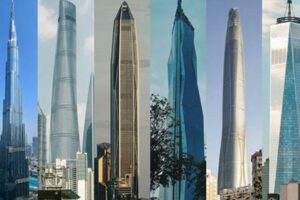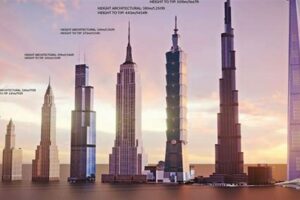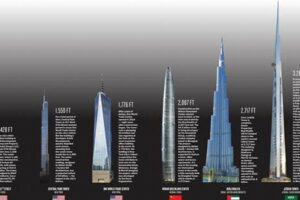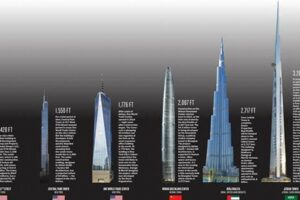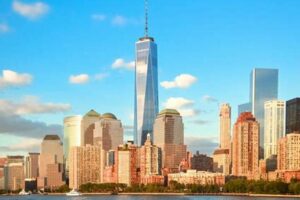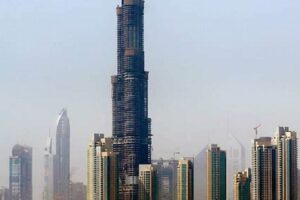The Burj Khalifa, located in Dubai, United Arab Emirates, holds the title of the tallest skyscraper in the world. Standing at an astonishing 828 meters (2,717 feet) tall, this architectural marvel has redefined the skylines of cities and pushed the boundaries of engineering.
Beyond its record-breaking height, the Burj Khalifa also boasts an array of luxurious amenities and cutting-edge technology. It houses world-class restaurants, elegant residential apartments, and state-of-the-art offices. The building’s design incorporates sustainable features, reducing its environmental impact while providing unparalleled comfort to its occupants.
The construction of the Burj Khalifa commenced in 2004 and was completed in 2009. The project not only transformed Dubai’s cityscape but also played a significant role in bolstering the city’s economy. The building has become an iconic landmark, attracting tourists from around the globe and serving as a symbol of Dubai’s ambition and innovation.
1. Height
The Burj Khalifa’s height of 828 meters (2,717 feet) is a defining characteristic that sets it apart as the tallest skyscraper in the world. This extraordinary height has several implications and facets:
- Engineering Marvel: Achieving such a remarkable height required innovative engineering techniques and materials. The Burj Khalifa’s structure incorporates a reinforced concrete core and steel exterior, allowing it to withstand high winds and seismic activity.
- Architectural Icon: The Burj Khalifa’s towering presence has transformed Dubai’s skyline, making it a globally recognized architectural icon. Its unique design, inspired by the desert flower Hymenocallis, has become synonymous with the city’s ambition and modernity.
- Observation Deck: The Burj Khalifa’s observation deck, aptly named “At The Top,” offers unparalleled panoramic views of Dubai and its surroundings. Visitors can ascend to different levels, including the highest outdoor observation deck in the world, providing breathtaking perspectives.
- Vertical City: The Burj Khalifa’s height has enabled the creation of a vertical city within a single structure. It houses a mix of residential apartments, office spaces, retail outlets, and hospitality venues, fostering a vibrant and diverse community.
In conclusion, the height of 828 meters (2,717 feet) is not merely a numerical value but a testament to the Burj Khalifa’s exceptional engineering, architectural significance, and the creation of a unique urban environment within its towering structure.
2. Floors
The Burj Khalifa’s 163 floors are a direct consequence of its extraordinary height, and both aspects are inextricably linked to its status as the tallest skyscraper in the world. This combination has several profound implications:
- Vertical Space Utilization: The 163 floors allow for efficient utilization of vertical space, accommodating a diverse range of functions and facilities within a single structure. This vertical stacking maximizes land use and creates a more compact urban environment.
- Zoned Living and Functionality: The division of the Burj Khalifa into 163 floors enables the creation of distinct zones dedicated to specific purposes, such as residential, commercial, hospitality, and leisure. This zoning enhances convenience and optimizes space utilization.
- Elevator and Transportation Systems: The sheer number of floors necessitates sophisticated elevator and transportation systems to ensure efficient vertical movement within the building. The Burj Khalifa employs a network of high-speed elevators, including double-decker elevators, to facilitate seamless and rapid transit between floors.
- Structural Stability: Achieving structural stability in a building with 163 floors requires innovative engineering solutions. The Burj Khalifa’s reinforced concrete core and exterior steel framework provide exceptional strength and stability, enabling it to withstand high winds and seismic forces.
In conclusion, the 163 floors of the Burj Khalifa are not merely a numerical value but a testament to the building’s efficient vertical space utilization, zoned functionality, advanced transportation systems, and unwavering structural stability, all of which contribute to its status as the world’s tallest skyscraper.
3. Architect
Adrian Smith, a world-renowned architect, played a pivotal role in the creation of the Burj Khalifa, the tallest skyscraper in the world located in Dubai. His contributions to this architectural marvel are significant and multifaceted:
- Design Concept: As the lead architect of Adrian Smith + Gordon Gill Architecture, Adrian Smith was responsible for the overall design concept of the Burj Khalifa. He drew inspiration from the Hymenocallis flower, a desert plant known for its symmetrical form and ability to thrive in harsh environments, to create the building’s distinctive shape.
- Structural Engineering: Smith’s expertise in structural engineering was crucial in ensuring the stability and integrity of the Burj Khalifa. He developed innovative solutions to overcome the challenges posed by the building’s unprecedented height, including the use of a reinforced concrete core and a steel exterior.
- Sustainability Considerations: Adrian Smith is known for his commitment to sustainable architecture, and this is evident in the design of the Burj Khalifa. The building incorporates energy-efficient features, such as a double-skin facade and automated lighting systems, reducing its environmental impact.
Adrian Smith’s vision, coupled with his engineering prowess and dedication to sustainable practices, has made him an integral part of the Burj Khalifa’s success. His work has not only created an architectural icon but also set a new standard for high-rise construction worldwide.
4. Construction
The construction phase of the Burj Khalifa, spanning from 2004 to 2009, holds immense significance in the context of its status as the tallest skyscraper in the world.
Firstly, the duration of construction, taking approximately five years, underscores the immense scale and complexity of the project. The sheer size and height of the Burj Khalifa required meticulous planning, coordination, and execution, involving countless engineers, architects, and construction workers.
Secondly, the construction timeline showcases the rapid pace of innovation and advancements in the field of architecture and engineering. Within a span of five years, the Burj Khalifa was brought to life, pushing the boundaries of what was previously considered possible in high-rise construction.
Furthermore, the construction phase played a pivotal role in shaping Dubai’s urban landscape and global recognition. The Burj Khalifa became a symbol of Dubai’s ambition, attracting worldwide attention and solidifying the city’s position as a hub for innovation and architectural marvels.
5. Cost
The Burj Khalifa’s construction involved substantial financial investments, with a total cost estimated at $1.5 billion. This significant expenditure played a crucial role in shaping the building’s status as the tallest skyscraper in the world.
- Engineering and Materials: Constructing a building of such unprecedented height required innovative engineering solutions and premium materials. The Burj Khalifa’s reinforced concrete core, steel exterior, and aerodynamic design all contributed to its stability and longevity, demanding significant financial resources.
- Skilled Labor: Assembling a team of highly skilled architects, engineers, and construction workers was essential for the successful execution of the project. Their expertise and experience, from design to construction, came at a premium.
- Technological Advancements: The Burj Khalifa incorporated cutting-edge technologies, such as high-speed elevators, automated building management systems, and sustainable energy features. These advancements required substantial investments in research and development, adding to the overall cost.
- Global Recognition and Prestige: The aspiration to create the tallest skyscraper in the world carried significant financial implications. Dubai’s ambition to establish itself as a global hub for tourism, business, and innovation influenced the investment decisions.
The $1.5 billion cost of the Burj Khalifa not only represents the financial investment but also reflects the determination, vision, and innovative spirit that made this architectural marvel a reality. It stands as a testament to the transformative power of ambitious projects that push the boundaries of human ingenuity and engineering prowess.
6. Observation Deck
The observation deck known as “At The Top” is an integral component of the Burj Khalifa, the tallest skyscraper in the world located in Dubai. Its existence is not merely coincidental but rather a direct consequence of the building’s extraordinary height and architectural design.
The primary reason behind the observation deck’s significance lies in its ability to provide visitors with an unparalleled, breathtaking experience. Situated at a staggering height, “At The Top” offers panoramic views of Dubai and its surrounding landscapes, stretching as far as the eye can see. This unique perspective allows visitors to appreciate the city’s architectural marvels, including the iconic Palm Jumeirah and the Dubai Marina, from a completely new and awe-inspiring angle.
Furthermore, the observation deck’s existence serves as a testament to the Burj Khalifa’s commitment to innovation and pushing architectural boundaries. By incorporating an observation deck into the building’s design, the architects and engineers behind the project demonstrated their vision to create a structure that not only breaks height records but also offers an unforgettable and immersive experience for visitors.
In conclusion, the observation deck “At The Top” is not merely an add-on feature but an essential element that complements the Burj Khalifa’s status as the tallest skyscraper in the world. It provides visitors with an unparalleled opportunity to witness the architectural wonders of Dubai from a breathtaking perspective, solidifying the building’s position as a global icon and a must-visit destination.
7. Hotel
Nestled within the iconic Burj Khalifa, the tallest skyscraper in the world located in Dubai, the Armani Hotel Dubai holds a special significance that extends beyond its luxurious accommodations and world-renowned reputation. Its existence is intricately linked to the building’s architectural marvel and global recognition.
- Exclusive Location:
The Armani Hotel Dubai occupies the lower floors of the Burj Khalifa, offering its guests unparalleled access to the world’s tallest structure. This exclusive location provides breathtaking views of the city and beyond, making it a sought-after destination for discerning travelers.
- Unparalleled Luxury:
As part of the Burj Khalifa, the Armani Hotel Dubai embodies the height of luxury and sophistication. Its elegant interiors, designed by Giorgio Armani himself, reflect the building’s modern and cosmopolitan aesthetic. Guests can indulge in a range of amenities, including a world-class spa, fine dining restaurants, and an exclusive cigar lounge.
- Architectural Integration:
The Armani Hotel Dubai seamlessly blends with the architectural design of the Burj Khalifa. Its interiors complement the building’s sleek lines and geometric forms, creating a harmonious and visually stunning environment. The hotel’s facade, adorned with the Armani logo, further reinforces its connection to the iconic skyscraper.
- Global Recognition:
The presence of the Armani Hotel Dubai within the Burj Khalifa contributes to the building’s global recognition and appeal. The hotel’s association with the world’s tallest skyscraper elevates its status and attracts guests from around the world, eager to experience the ultimate combination of luxury and architectural grandeur.
In conclusion, the Armani Hotel Dubai’s connection to the tallest skyscraper in the world, the Burj Khalifa, is not merely coincidental but rather a strategic alliance that enhances the reputation, exclusivity, and architectural significance of both the hotel and the building. It stands as a testament to the transformative power of collaboration and the pursuit of excellence in the realm of architecture and hospitality.
8. Residential
The inclusion of 900 residential apartments within the Burj Khalifa, the tallest skyscraper in the world located in Dubai, is not merely a matter of providing housing units but rather a strategic decision that reinforces the building’s significance and functionality as a mixed-use development.
The integration of residential space within the Burj Khalifa serves several important purposes. Firstly, it contributes to the building’s overall financial viability. Rental income from the apartments generates a steady revenue stream, offsetting the substantial construction and maintenance costs associated with such a colossal structure.
Secondly, the residential component enhances the building’s appeal and marketability. By offering exclusive residential units within the world’s tallest skyscraper, the Burj Khalifa attracts discerning individuals and families seeking a unique and prestigious living experience. This, in turn, elevates the building’s status as a global icon and a sought-after destination.
Furthermore, the presence of residential apartments fosters a sense of community and vibrancy within the Burj Khalifa. Residents become an integral part of the building’s ecosystem, creating a diverse and dynamic environment that extends beyond the realm of tourism and commercial activities.
9. Offices
The allocation of 1.85 million square feet to office space within the Burj Khalifa, the tallest skyscraper in the world located in Dubai, is a strategic move that underscores the building’s multifunctional nature and its role as a global business hub.
- Economic Significance:
The vast office space available within the Burj Khalifa attracts multinational corporations, financial institutions, and other businesses seeking a prestigious and highly visible address. This concentration of businesses contributes to Dubai’s economic growth and reinforces its position as a regional and international business center.
- Vertical Business Community:
The presence of numerous offices within the Burj Khalifa fosters a vibrant vertical business community. Tenants benefit from proximity to potential clients, partners, and collaborators, creating a dynamic and interconnected business ecosystem.
- Efficient Space Utilization:
The Burj Khalifa’s height allows for efficient utilization of space. By stacking offices vertically, the building maximizes its footprint while minimizing its physical presence on the ground, contributing to sustainable urban planning.
- Global Recognition and Prestige:
Companies that establish their offices within the Burj Khalifa gain instant recognition and prestige. The building’s iconic status as the world’s tallest skyscraper enhances their corporate image and adds to their appeal in attracting top talent.
In conclusion, the allocation of 1.85 million square feet to office space within the Burj Khalifa is not merely a design feature but a strategic decision that reinforces the building’s significance as a global business hub. It contributes to Dubai’s economic growth, fosters a vibrant business community, optimizes space utilization, and enhances the prestige of its tenants.
FAQs about the Tallest Skyscraper in the World
The Burj Khalifa, an architectural marvel in Dubai, attracts global attention due to its extraordinary height and innovative design. To address common questions, here are comprehensive responses:
Question 1: What is the exact height of the Burj Khalifa?
The Burj Khalifa stands at an impressive 828 meters (2,717 feet) tall, making it the tallest building in the world by a significant margin.
Question 2: How many floors does the Burj Khalifa have?
The Burj Khalifa boasts 163 floors, offering ample space for residential, commercial, and hospitality purposes.
Question 3: Who was the architect behind the Burj Khalifa?
The renowned architect Adrian Smith, known for his innovative designs, conceptualized and led the architectural team for the Burj Khalifa.
Question 4: How long did it take to construct the Burj Khalifa?
The construction of the Burj Khalifa was a remarkable feat, spanning from 2004 to 2009, showcasing the dedication and expertise of the construction team.
Question 5: What is the estimated cost of constructing the Burj Khalifa?
The total cost of constructing the Burj Khalifa is estimated to be around $1.5 billion, reflecting the extensive resources and cutting-edge technologies employed.
Question 6: What is the purpose of the observation deck in the Burj Khalifa?
“At The Top,” the observation deck in the Burj Khalifa, provides visitors with breathtaking panoramic views of Dubai and its surroundings from an unparalleled vantage point.
In conclusion, the Burj Khalifa is not just a skyscraper but an architectural icon that symbolizes Dubai’s ambition and innovation. Its impressive height, thoughtful design, and diverse functionality make it a marvel that continues to capture the imagination of people worldwide.
Transition to the next article section: Exploring the Architectural Significance of the Burj Khalifa
Tips for Admiring the Tallest Skyscraper in the World
To fully appreciate the architectural marvel that is the Burj Khalifa, the tallest skyscraper in the world, consider these insightful tips:
Tip 1: Plan Your Visit: Plan your visit during off-peak hours or weekdays to avoid crowds and ensure a more serene experience.
Tip 2: Book Observation Deck Tickets in Advance: Secure your tickets for “At The Top,” the observation deck, online to avoid disappointment and guarantee your preferred time slot.
Tip 3: Explore the Dubai Mall: Begin your Burj Khalifa experience by exploring the adjacent Dubai Mall, one of the largest shopping malls globally, offering a diverse range of retail, dining, and entertainment options.
Tip 4: Capture Panoramic Views: Position yourself strategically on the observation deck to capture stunning panoramic views of Dubai’s iconic landmarks, including the Dubai Fountain and Palm Jumeirah.
Tip 5: Learn about its Architectural Significance: Engage with the informative exhibits and displays on the observation deck to gain insights into the Burj Khalifa’s innovative design, engineering marvels, and sustainability features.
Tip 6: Savor a Meal at Atmosphere: Treat yourself to an unforgettable dining experience at Atmosphere, the world’s highest restaurant, located on the 122nd floor of the Burj Khalifa.
Tip 7: Enjoy the Dubai Fountain Show: Time your visit to coincide with the mesmerizing Dubai Fountain Show at the base of the Burj Khalifa, offering a spectacular display of water, music, and lights.
Tip 8: Admire from a Distance: For a different perspective, take a stroll around the Burj Khalifa Lake or visit nearby attractions like the Dubai Opera or Souk Al Bahar to admire the skyscraper’s grandeur from afar.
Conclusion
The Burj Khalifa, an architectural marvel and the tallest skyscraper in the world, stands as a testament to human ambition and engineering ingenuity. Its innovative design, sustainable features, and diverse functionality have transformed Dubai’s skyline and solidified its position as a global hub for tourism, business, and innovation.
Beyond its physical grandeur, the Burj Khalifa serves as an inspiration to dream big and push the boundaries of what is possible. It invites us to look up, appreciate the wonders of modern architecture, and strive for excellence in all our endeavors.


